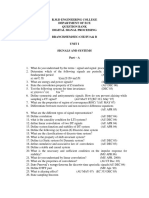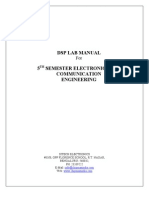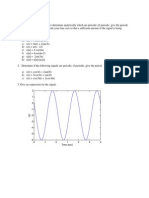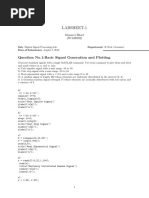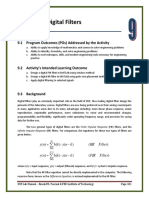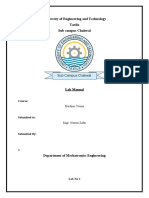MATLAB Code For Musical Notes Recognition
Uploaded by
Shanza Tariq 538-FET/BSEE/F18MATLAB Code For Musical Notes Recognition
Uploaded by
Shanza Tariq 538-FET/BSEE/F18MATLAB code for musical notes
recognition
clear;
clc;
close all;
% Note Recognition
%% Note Initialization
mainNames = char('C', 'C#', 'D', 'D#', 'E', 'F', 'F#', 'G', 'G#', 'A', 'A#',
'B');
names = char('A0', 'A#0' ,'B0');
A0 = 27.5;
ind = 4;
for i = 0:87
data(i+1) = A0 * (2^(1/12))^i;
if i>2
a = [mainNames( rem((ind - 4), 12)+1,:) num2str(fix((ind - 4)/12)+1)];
names = char(names, a);
ind = ind + 1;
end
end
% Band Initialization
bands(1) = 20;
for i = 1:87
bands(i+1) = +7+(data(i) + data(i+1))/2;
end
bands(89) = 4500;
%%
fileName = 'c.wav'; % File name
[y, Fs] = audioread(fileName); % Read audio file
y = (y(:,1) + y(:,2))*4; % Decrease 2 channels to 1
%y = (y(:,1));
y(1:2:end) = 0; %from big vector take only odd index values % Do
decimation(decreace the no of samples)
frameLength = 4410*2; % 2 Güzel oldu
endPart = frameLength*ceil(length(y)/frameLength); % complete the last frame
%ceil is to round off to nearest integer
y(length(y)+1 : endPart) = 0;
f = linspace(1,Fs,frameLength); %creates linearly spaced vector
%%
harmonics = 0;
for i = 1:round(length(y)/frameLength) % For each frame
% Divide audio into frames
frames(i, 1:frameLength) = y( (frameLength*(i-1)+1):(frameLength*i) )';
frame = y( (frameLength*(i-1)+1):(frameLength*i) )';
frame = frame .* hamming(length(frame))'; % Hamming Window
fframe = abs(fft(frame)); % FFT
fp = sum(fframe);
p = sum(abs(frame));
b = true;
if(p < 200 || fp < 1000) % Put a threshold for processing
b = false;
end
% Bands
for i=1:88
freqBand(i) = mean(fframe(
round(bands(i)/(Fs/frameLength) ):round(bands(i+1)/(Fs/frameLength))))^2;
end
% Plotting
subplot(3,1,1)
stem(freqBand)
subplot(3,1,2)
plot(fframe)
xlim([0,500])
subplot(3,1,3)
plot(fframe)
ylim([-1 1])
hold off
pause(0.1)
sound(fframe,Fs)
% Desicion
m = find(freqBand == max(freqBand(:)));
if(b) disp(names(m,:)); % Print the result
else disp('.'); end
if(b)
index = 1;
for i = 1:88
if(freqBand(i) > 2000)
harmonics(index) = i;
index = index+1;
end
end
end
end
You might also like
- Application of DSP in Video CompressionNo ratings yetApplication of DSP in Video Compression12 pages
- Advanced Programming in MATLAB - Aaron Ponti PDFNo ratings yetAdvanced Programming in MATLAB - Aaron Ponti PDF84 pages
- Digital Signal Processing R13 Previous Papers100% (1)Digital Signal Processing R13 Previous Papers5 pages
- Matlab Code: LMS Adaptive Noise CancellationNo ratings yetMatlab Code: LMS Adaptive Noise Cancellation3 pages
- DSP Lab Manual 5 Semester Electronics and Communication EngineeringNo ratings yetDSP Lab Manual 5 Semester Electronics and Communication Engineering147 pages
- Ec6702 Optical Communication and NetworksNo ratings yetEc6702 Optical Communication and Networks36 pages
- Ec8093-Digital Image Processing: Dr.K.Kalaivani Associate Professor Dept. of EIE Easwari Engineering CollegeNo ratings yetEc8093-Digital Image Processing: Dr.K.Kalaivani Associate Professor Dept. of EIE Easwari Engineering College41 pages
- Frequency Hopping Spread Spectrum (FHSS)No ratings yetFrequency Hopping Spread Spectrum (FHSS)10 pages
- M.tech. (Digital Systems & Signal Processing)No ratings yetM.tech. (Digital Systems & Signal Processing)41 pages
- Write A Mat Lab Program To Perform Linear and Circular Convolution of The Discrete Time Sequences X50% (2)Write A Mat Lab Program To Perform Linear and Circular Convolution of The Discrete Time Sequences X26 pages
- Fourier Transform (For Non-Periodic Signals)No ratings yetFourier Transform (For Non-Periodic Signals)27 pages
- Labsheet-1: Question No.1:Basic Signal Generation and PlottingNo ratings yetLabsheet-1: Question No.1:Basic Signal Generation and Plotting15 pages
- Wireless Communications and Networks: William StallingsNo ratings yetWireless Communications and Networks: William Stallings24 pages
- 11.instructional Manual Sample Program OutputNo ratings yet11.instructional Manual Sample Program Output30 pages
- Image Analysis and Markov Random Fields (MRFS)No ratings yetImage Analysis and Markov Random Fields (MRFS)22 pages
- M.tech - Communication Engineering and Signal ProcessingNo ratings yetM.tech - Communication Engineering and Signal Processing19 pages
- Fundamentals of Image Processing Lab Manual 2014 PDFNo ratings yetFundamentals of Image Processing Lab Manual 2014 PDF68 pages
- Aim: To Convert CD To DVD Data Software: Matlab 2013A TheoryNo ratings yetAim: To Convert CD To DVD Data Software: Matlab 2013A Theory2 pages
- Network Analysis and Synthesis: Subject Code EC203 Credits: 3 Total Hours: 42No ratings yetNetwork Analysis and Synthesis: Subject Code EC203 Credits: 3 Total Hours: 421 page
- 4 Digital Signal Processing in Simulink 2007 PDFNo ratings yet4 Digital Signal Processing in Simulink 2007 PDF58 pages

